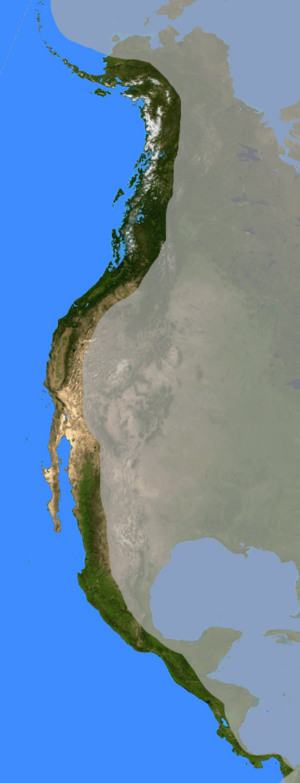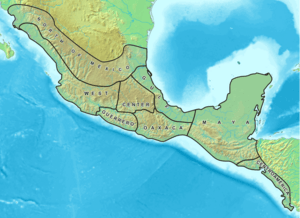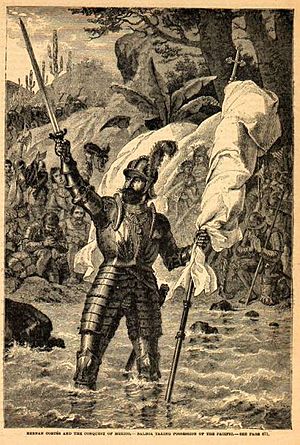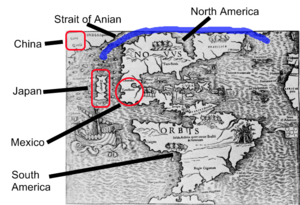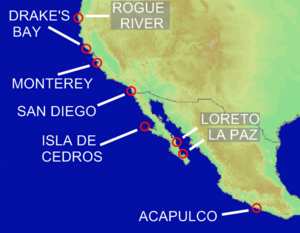History of the west coast of North America facts for kids
The history of the west coast of North America is a long and exciting story. It begins with the first people who arrived on the continent. They came thousands of years ago. Later, amazing cultures developed in this area. Then, European explorers and settlers arrived. Today, the west coast of North America is a very important place. It has huge companies and is a center for world culture.
Contents
Where is the West Coast?
When we talk about the "west coast of North America," we mean the land next to the Pacific Ocean. This includes parts of:
- The U.S. states of Alaska, Washington, Oregon, and California.
- Parts of British Columbia and the Yukon in Canada.
- Parts of Mexican states like Baja California and Chiapas.
- Central American countries like Guatemala, El Salvador, and Panama.
Islands near the coast, like the Channel Islands of California, are also important.
First People Arrive
The west coast of North America was likely one of the first places where people settled. Most scientists believe the first groups came from Asia. They crossed the Bering Strait area into what is now Alaska. From there, they spread across North and South America.
Even though early cultures in Canada and the U.S. did not build big cities or complex writing systems, many people lived there. Before Europeans arrived, the population was likely much higher than in other northern parts of the continent. For example, it's thought that in 1492, about one-third of all Native Americans in the U.S. lived in what is now California.
The Channel Islands in California show the earliest proof of people using boats in the Americas. People lived there at least 13,000 years ago. The oldest human remains found in the Los Angeles area are over 23,600 years old.
On Cedros Island off Mexico, people lived about 11,000 years ago. They found the oldest fishhooks in the Americas there. These early fishers caught deep-water fish. This means they must have used boats. These island people traded with the mainland for thousands of years.
Early Civilizations and Settlements
In the western part of Mesoamerica (today's Mexico and northern Central America), larger towns appeared around 2000 BCE. The Capacha culture started on Mexico's Pacific coast around 1450 BC. It then spread inland.
Later, these cultures grew into "high civilizations" in Mesoamerica. They had large cities, writing, astronomy, and beautiful art. Some of these cultures include:
- The Olmec (starting around 1150 BC).
- The Mixtec (around 1000 BC).
- The Maya (villages from 1800 BC, ceremonial buildings by 1000 BC).
- The Aztec (from the 14th century AD).
Further south, Panama had some of the earliest pottery makers. The Monagrillo culture (2500–1700 BC) is an example. This culture later developed into groups known for amazing burial sites and colorful pottery.
These cultures rose and fell, often conquered by stronger groups. Even if they didn't have big cities right on the Pacific coast, their influence reached there. There is proof of trade routes along the west coast. These routes connected areas from central Mexico all the way to Central America.
Europeans Arrive (1513–1750)
In 1513, Spanish explorers were the first Europeans to reach the west coast of North America. They arrived on the Pacific coast of Panama. For Europeans, the west coast of North America was one of the farthest places in the world. Traveling around Cape Horn at the tip of South America took nine to twelve months. It was a very dangerous journey. Because of these difficulties, only Spain made regular visits and built settlements. This was for about 200 years after Europeans first reached the east coast of North America.
Spanish Explorers and Conquerors
Spanish expeditions began exploring the "New World" in 1492 with Christopher Columbus. Spain was given rights by the Pope to colonize the entire Western Hemisphere. This included all of the west coast of North America.
The first European to reach the Pacific coast was Vasco Núñez de Balboa in Panama in 1513. Balboa claimed the Pacific Ocean for the Spanish King. He also claimed all the land and islands touching it. This act gave Spain control over the entire west coast of North America.
Many people at the time believed that Asia was very close to the west coast of North America. Some thought they might even be connected. To the north, people imagined a narrow Northwest Passage. They called it the Strait of Anián. They thought it connected the Pacific Ocean to the Atlantic Ocean. Spain wanted to find this strait to create direct trade routes with China and other Asian countries.
The Pacific Coast of Mexico and Central America was not easy to develop. The northern Mexican coast was too dry for farming. The jungles and tropical diseases further south made large-scale development difficult.
However, important Spanish ports grew at Puerto de Navidad and Acapulco in Mexico. Acapulco became Spain's main port on the west coast. It was used for explorations north and for trade with Asia.
From 1533 to 1535, Hernán Cortés explored north from Acapulco. He was looking for legendary riches in what is now California. He likely reached La Paz on the Baja California peninsula.
In 1539, Francisco de Ulloa sailed north from Acapulco. He explored the Pacific Coast and searched for the Strait of Anián. He sailed into the Gulf of California, which he named the "Sea of Cortés." He sailed along the Baja California peninsula but could not find the strait. He turned back after reaching 28° north latitude.
Later voyages by Hernando de Alarcón (1540) and Francisco de Bolaños (1541) explored more of Baja California. Alarcón explored the lower Colorado River. The name "California" for this region might have come from Bolaños or Alarcón.
In 1542, Juan Rodríguez Cabrillo became the first European to explore the west coast of today's United States. He landed at San Diego Bay and sailed north to Oregon. Cabrillo died during the trip, and Bartolomé Ferrer continued the exploration.
Acapulco became home to the important Manila Galleons starting in 1565. These ships crossed the Pacific to the Philippines. They carried silver and jewels from Mexico. In the Philippines, they bought Asian goods like spices, silk, and porcelain. These goods were then brought back to Acapulco. From there, they were sent across Mexico to Spain. The Manila Galleons brought huge wealth to Spain.
Returning from the Philippines was a long and difficult journey. In 1565, Andrés de Urdaneta found a route that used ocean currents. This route was used by galleons for nearly 300 years. It could take up to seven months. Sailors wanted a safe harbor on the California coast.
In 1585, Captain Francisco de Gali mapped parts of the California coast. He reached the coast near today's San Francisco. He noted the land was high and fair. In 1594, Sebastião Rodrigues Soromenho sailed from the Philippines. His ship, the San Agustin, was wrecked in Drakes Bay. The crew built a small open boat and sailed nearly 2,500 miles back to Acapulco. After this, ships carrying cargo from the Philippines stopped exploring the California coast.
In 1602, Sebastián Vizcaíno explored the coast from Mexico to Monterey Bay in California. He made detailed maps that were used for almost 200 years. However, no settlements were built in California for another 150 years.
In the late 1600s, Spain sent missionaries to Baja California. The first permanent mission was established in 1697 at Loreto. By 1750, about 16 missions were built on the peninsula.
English Interest
In 1579, the English explorer Francis Drake visited the west coast of North America. He landed at Drake's Bay and claimed the area for England. He called it New Albion. England did not build any settlements there. The next official English visit was 200 years later. However, Drake's actions helped form the basis of British claims to parts of the west coast. These claims were later given to the United States.
Settlements and Conflicts (1750–1846)
For over 200 years, Spain was the main power on the west coast. But in the mid-1700s, things changed. British and Russian fur traders arrived. Spain built more missions in California. Later, Mexico and Central American countries became independent. Eventually, the United States became the most powerful nation on the west coast.
Spanish Settlements in New Spain
In the 1760s, Spain decided to build a new port at San Blas in Mexico. This port would build and supply ships. It would be the base for voyages north along the west coast, all the way to Alaska. San Blas built ships and was the home port for these trips from 1769 to 1820.
Spanish Missions in California
In 1769, the first missions were built in what is now California. The first was Mission San Diego in 1769. Others followed, like Monterey in 1770 and San Francisco in 1776. These missions stretched from Baja California to Sonoma, north of San Francisco. The missions, along with towns and military forts, helped Spain strengthen its claim to the region. This was important because Russians and British were setting up fur trading posts further north.
Russian Settlements
Explorers and fur trappers from the Russian Empire arrived on the Pacific coast of Alaska. They started settlements there in 1784. They expanded their hunting and trading south along the west coast. In 1812, the Russian-American Company built a fort called Fort Ross. It was north of San Francisco. They hoped to grow food there for their settlements in Alaska.
Spanish Exploration of the Pacific Northwest
In the late 1700s, Spain reacted to the growing Russian and British presence. They sent expeditions north to Alaska. In 1774, Juan José Pérez Hernández explored the coast. He met the Haida and Nuu-chah-nulth people. In 1775, Bruno de Heceta landed on the coast of today's Washington. He was the first European to sail that far north. He claimed the coastal lands for Spain. He also saw the mouth of the Columbia River.
Another ship, led by Juan Francisco de la Bodega y Quadra, reached 59° north latitude in Alaska. They claimed areas like Sitka Sound for Spain. In 1790, Salvador Fidalgo visited today's Cordova and Valdez in Alaska. He also went to Russian settlements on Kodiak Island and the Kenai Peninsula. He re-asserted Spain's claim to these areas.
In 1791, the Malaspina Expedition searched for the Northwest Passage. They explored the Alaska coast and met the Tlingit people. They studied their culture and made drawings. Later, a glacier was named after Malaspina.
Today, many Spanish place names remain. In Alaska, you can find Malaspina Glacier and the towns of Valdez and Cordova. In British Columbia, there are Quadra Island and Galiano Island.
British North America
In 1778, British Captain James Cook mapped the west coast from California to the Bering Strait. The British claimed the northern part of the west coast. However, no British subjects settled there until 1788. That year, John Meares set up a small trading post in Nootka Sound in British Columbia.
Conflict Between Spain and Great Britain
Spain built its own fort at Nootka Sound. They tried to remove British traders by seizing their ships. This led to the Nootka Crisis. War between Spain and Great Britain was avoided by agreements called the Nootka Conventions (1790, 1793, 1794). Spain gave up its claim to be the only nation that could settle the Pacific Northwest. This allowed Britain to establish settlements there.
The Hudson's Bay Company greatly benefited from this agreement. In 1825, they built a major trading post at Fort Vancouver in today's Oregon. Their fur trappers spread throughout the Pacific Northwest, even into California.
Mexican Independence
In 1821, Mexico won its independence from Spain. Mexico kept Spain's missions and claims along the Pacific coast. In the 1830s, Mexico ended the Church's control of the missions in California. The land was opened for ranching. By the 1840s, small Mexican settlements existed in San Diego, Los Angeles, San Francisco, and Monterey. They traded cattle hides and fat with American and European ships. Mexican control of California ended after only 25 years. This happened after American ranchers rebelled in the Bear Flag Revolt.
Central American Independence
During the 1820s, the Central American countries also gained independence from Spain. Their borders and alliances changed often. Most of these nations faced political struggles. They also started to grow coffee and bananas, often with U.S. investment. In 1903, Panama became independent. This led to the creation of the Panama Canal in 1914. The Canal helped the region's economy by making trade with the Eastern U.S. and Europe much easier.
French Interest
In 1786, French scientists and artists visited Monterey, California. They studied the California mission system and the people. In 1840, a French explorer wrote that California would belong to any nation that sent a warship and 200 men. Mexican officials also worried that France wanted to control California.
U.S. Expansion
In 1805, the Lewis and Clark Expedition became the first official group of Americans to reach the west coast. They traveled down the Columbia River to its mouth. In 1819, the United States gained Spain's claims to the Pacific Northwest. This led to a dispute with Britain called the Oregon boundary dispute. The two countries agreed to share the land for a while. This area was known as the Oregon Country.
Americans began arriving in large numbers in the mid-1830s. They came overland on the Oregon Trail and settled in Oregon. By 1841, American settlers reached California on the California Trail. By the mid-1840s, many Americans were arriving in California.
In 1846, the Oregon Treaty settled the dispute between the U.S. and Great Britain. It divided the Oregon Country along what is now the border between Canada and the United States.
Rapid Growth (1846–1945)
During this time, the west coast of North America changed a lot. Many non-native people moved in. The U.S. west coast saw the biggest changes. This began with the California Gold Rush and the building of transcontinental railroads. Later, Hollywood grew in Southern California. Industry and farming also increased in the U.S. Pacific Northwest. Canada and Mexico also developed, but at a slower pace.
United States
Americans in California rebelled against Mexico in 1846. They created the short-lived California Republic. However, the Mexican–American War had already started. The American military quickly took control of California. At the end of the war, Mexico gave California to the United States.
Things changed greatly in 1848 with the California Gold Rush. Many people from across the U.S. and around the world moved there. Few found much gold, but many stayed. They started communities and began farming. The first transcontinental railroads were finished in 1869. This made it cheap and easy for people to move to the west coast.
In 1867, the United States bought Alaska from the Russian Empire. This completed American expansion across North America.
The next 75 years saw huge changes. Farming, oil, entertainment, and industry made California's population grow. Logging, fishing, and industry drove the economies of California, Oregon, and Washington. Alaska's economy was smaller due to high costs, even with gold rushes and fishing.
During World War II, defense companies like Boeing and Kaiser Shipyards were very important. They made wartime goods on the West Coast, especially in Seattle, Portland, and Los Angeles. Military spending in Alaska also increased because of the threat from Japan. Japan launched some attacks on the Pacific Coast. These included the Bombardment of Ellwood and balloon bombs.
Canada
The gold rush fever spread north. In 1858, the Fraser Canyon Gold Rush began in British Columbia. At the end of the century, the Klondike Gold Rush brought many prospectors to the Yukon.
Britain worried about losing its Pacific lands. In 1871, British Columbia joined Canadian Confederation. Canada promised to build a railway to British Columbia. The Canadian Pacific Railway was finished in 1885. This new line became an important link for travel around the British Empire.
Mexico and Central America
The Pacific Coast of Mexico remained less developed. Exceptions were tobacco farming in Nayarit, tourism in Acapulco, and local fishing. Central American countries continued to face political struggles. They expanded farming, especially coffee and bananas.
Immigration
The gold rushes and railroads needed many workers. Many immigrants from East Asia, mainly China and Japan, came to work. They worked for low wages and helped build the west coast's infrastructure. However, they faced constant unfair treatment. Asians were denied their civil rights in both the U.S. and Canada. Laws were passed to limit or ban Asian immigration in the 1920s. Because of this unfair treatment, Chinatowns developed in major west coast cities.
Increased Trade and World War II
The rise of Japan's economy helped the region. Trade across the Pacific grew. However, Japan later became a threat during World War II. There were few attacks on North America. Japan sent thousands of balloon bombs to try to start forest fires. These were mostly not effective. More harmful was the internment of people of Japanese descent. They were forced from their homes and sent to camps just because of their background.
Post-War Period (1945–Present)
The years after World War II brought great growth to the west coast. Japan's quick recovery and growth meant much wealth for west coast ports. Japan became a huge trading partner for Canada and the United States. Later, other Asian economies added to this trade.
In the Pacific Northwest, industries like logging, mining, and fishing remained central. California became a center for entertainment, aerospace, and electronics. After Alaska became a state in 1959, military spending and oil development helped its economy grow.
Unlike other parts of the U.S., the western economies were not based on manufacturing. So, the decline of manufacturing in the 1970s and 1980s did not hurt the west as much. This led to fast growth in the west and slower growth in the east.
During this time, the west coast moved towards conservatism, favoring lower taxes. In the U.S., this meant support for the Republican Party. Two Republican presidents from California, Richard Nixon and Ronald Reagan, were elected. In British Columbia, the Social Credit Party governed for over thirty years. However, cities like San Francisco and Vancouver also became centers for environmentalism, unions, feminism, and gay rights.
The economy of North America grew again in the late 1990s. Northern California saw growth due to the high-tech industry. Japan's economic slump hurt the region, but the rapid growth of Southeast Asia, South Korea, and especially China made up for it. The region also changed politically. People in the west became less conservative on some social issues. In 1991, British Columbia elected the social democratic New Democratic Party. California, Washington, and Oregon supported Democratic presidential candidates. However, inland areas of California and British Columbia remained more conservative.
|
See also
 In Spanish: Costa noroccidental de América del Norte para niños
In Spanish: Costa noroccidental de América del Norte para niños


